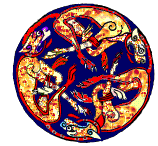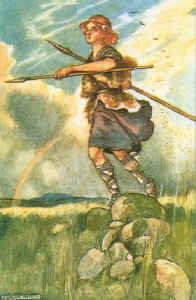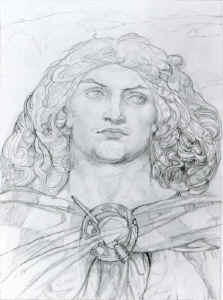|
|

|

|
Warriors,
Heroes & Villains
Cúchulainn
|

|
Name:
Cúchulainn  Cú Culaind
Cú Culaind  Cúchullin
Cúchullin
 Cúcán
Cúcán
 Cuculain
Cuculain

The Lineage of Cúchulainn
Cúchulainn was born Setanta son of human parents, Sualtam the warrior
hero and Dechtire half sister to Conchobar the King of Ulster. His divine lineage
includes the fact that he was an ancestor of the Dagda - the good god, and son of
Lugh the sun god or god of light.
Physical Attributes
Cúchulainn was short in stature yet no one could look upon him in his
splendor without blinking.
The heat of his body could melt snow and ice for yards
around, he glowed red and when he dipped his body in water to bathe the water hissed and
turned to steam. He could send himself into a battle fury which
This description is taken from a translation in The Cúchullin Saga
edited by Eleanor Hull in 1898:
' A handsome lad was he that stood there, Cúchulainn son of Sualtam.
Three colours of hair had he; next to his skin the hair was brown, in the middle it
was red; on the outside it was like a diadem of gold; comparable to yellow gold was each
glittering long curling splendid beautiful thread of hair, falling freely down between his
shoulders.
About his neck were a hundred tiny links of red gold flashing, with pendants
hung from them. His headgear was adorned with a hundred different jewels.
On
either cheek he had four moles, a yellow, a green, a blue and a red. In either eye
he had seven pupils, sparkling like seven gems. Each of his feet had seven toes,
each of his hands seven fingers; his hands and feet were endowed with the clutching power
of hawk's talons and hedgehog's claws.
 He wore his gorgeous raiment for great gatherings; a fair crimson tunic of
five plies all He wore his gorgeous raiment for great gatherings; a fair crimson tunic of
five plies all
The champion carried a trusty special shield coloured dark crimson with a
pure white silver rim all around its circumference; at his left side hung a long golden
hilted sword.
Beside him in his chariot was a lengthy spear, together with a keen
aggressive javelin fitted with a hurling thong and rivets of white bronze.
In one hand he
carried nine heads, and nine more in the other; he held these heads as emblems of his
valour and skill in arms, and at the sight of him the opposing army shook with terror.'
Images:
Drawing of Cúchulainn by John Duncan, Scottish 19th C. artist
Watercolour
of the young Setanta by Stephen Reid 1910.
|
The Battle Fury of Cúchulainn
' Then it was that he suffered his riastradh or paroxysm, whereby
he became a fearsome and multiform and wondrous and hitherto unknown being. All
over him, from his crown to the ground, his flesh and every limb and joint and point and
articulation of him quivered as does a tree, yea a bulrush, in mid-current.
Within in his skin he put forth an unnatural effort of his body: his feet,
his shins, and his knees shifted themselves and were behind him; his heels and calves and
hams were displaced to the front of his leg-bones, in condition such that their knotted
muscles stood up in lumps large as the clenched fist of fighting man. The frontal
sinews of his head were dragged to the back of his neck, where they showed in lumps bigger
than the head of a man-child aged one month. Then his face underwent extraordinary
transformation: one eye became engulfed in his head so far that 'tis a question whether a
wild heron could have got at it where it lay against his occiput, to drag it out upon the
surface of his cheek; the other eye on the contrary protruded suddenly, and of itself so
rested upon the cheek. His mouth was twisted awry till it met his ears. His
lion's gnashings caused flakes of fire, each one larger than fleece of three-year-old
wether, to stream from his throat into his mouth and so outwards. The sounding blows
of the heart that panted within him were as the howl of a ban-dog doing his office, or of
a lion in the act of charging bears.
Among the clouds over his head were visible the virulent pouring showers
and sparks of ruddy fire which the seething of his savage wrath caused to mount up above
him. His hair became tangled about his head, as it had been branches of a red
thorn-bush stuffed into a strongly fenced gap to block it; over the which though a prime
apple-tree had been shaken, yet may we surmise that never an apple of them would have
reached the ground, but rather that all would have been held impaled each on an individual
hair as it bristled on him for fury.
His hero's paroxysm projected itself out of his forehead, and showed
longer than the whet-stone of a first-rate man-at-arms. Taller, thicker, more rigid,
longer than mast of a great ship was the perpendicular jet of dusky blood which out of his
scalp's very central point shot upwards and then was scattered to the four cardinal
points; whereby was formed a magic mist of gloom resembling the smoky pall that drapes a
regal dwelling, what time a king at night-fall of a winter's day draws near to it.'
Stories, Myths
and legends about Cúchulainn
There are many stories about Cúchulainn and his life some of them have
been christianised and details changed from earlier versions. There are differing
versions of his death in the Book of the Dun Cow (Leabhar na hUidre), and The Book of Leinster. Most
historians agree that the historical setting for the Cúchulainn stories is the 1st
century BC. Emain Macha was no longer in use after the 1st century AD. according to
archaeological evidence.
The Celtic method of single combat in battle
situations
Although a large army of men and women set out to do battle, combat was
primarily undertaken on a one to one basis. Warriors were chosen from each side who
would engage in combat with each other. The outcome would determine which side had won or
lost. This was seen to be preferable to all out combat in which many lives were lost
regardless of whoever was ultimately victorious. It was considered the height of barbarism
to waste human life needlessly when heroic champions were an integral part of Celtic
culture and had thus been specifically trained in the warrior arts - it was the champions
role to fight on behalf of many people rather than just themselves.
This was how Cúchulainn came to defend Ulster
single-handedly, instead of
being overwhelmed by the sheer numbers of the army of Queen Medb of Connaught he
defended his position by fighting warrior after warrior in single combat. He also
slew the totem animals of Queen Medb, the dog, the bird and the squirrel.
Further Reading:
Hull, E. The Cuchullin
Saga. London 1898.
Kinsella, T. (trans.) The Táin London, 1970.
Mc Cana, P. Celtic Mythology. London, 1970.
Newark, T. Celtic Warriors - Blandford Press, Poole, 1986.
Gregory,
Lady Augusta, Cuchulain of Muirthemne, 1910.
top

© Shee-Eire:
|
![]()